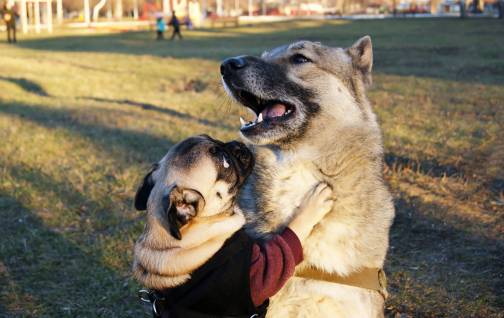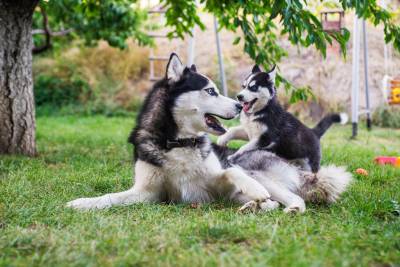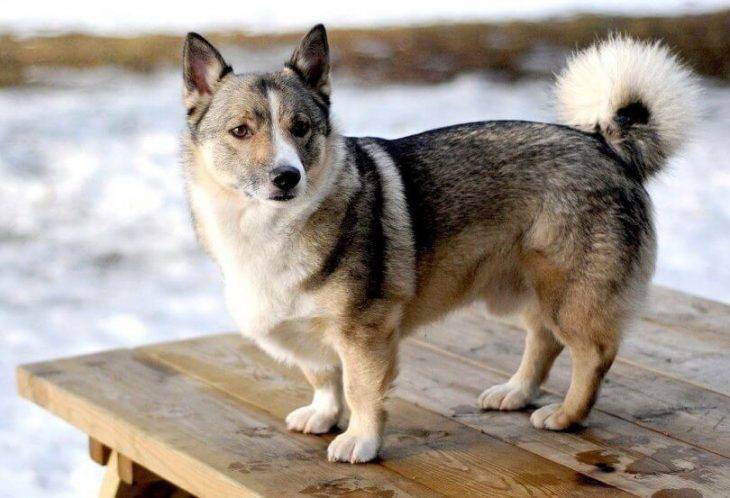Connect with a verified veterinarian in minutes. Licensed vets are available 24/7 to answer your questions. No need to worry about your furry family member.
Have you ever heard of the Hug dog? Are you curious to know more about this special dog? This is a dog that we’ve not heard of before! We did some research and learned some interesting things about these dogs!
We’ll explain what a Hug dog is, all about their temperament, and much more! Let’s get started!
What is a Hug Dog?
A Hug dog is a designer dog, which is a hybrid. They’re a cross between a Siberia Husky and a Pug. Wow! This is a very interesting type of Husky crossbred dog, known as a Hug! What a great name for a dog breed!
The Origins of the Hug Dog
Hug dogs come from two very distinguished dog breeds, Pugs and Siberian Huskies.
Pugs originally came from China, with a history that goes back to about 400 BC. Pugs were companions to Buddhist monks in Tibet, where they were very loved. By the 16th and 17th centuries, Pugs were discovered by Europeans. After being taken to Europe by Portuguese traders, Pugs became beloved pets to King William II and Queen Mary II of the Netherlands. From there, the dog made it to England. You can often find these small dogs in the paintings of royalty!
The Pub was first recognized by the AKC in 1885, and since then, the dogs have continued to gain in popularity in the US.
Siberian Huskies originally came from Northeast Asia, where they were bred by the Chukchi people of Siberia. The dogs were bred for pulling sleds and for their companionship. The dogs were imported to Alaska in the early 1900s during the gold rush, where the dogs were used to pull sleds. The Siberian Husky was first recognized by the AKC in 1930.
So, Hugs have wonderful, strong ancestors!

Review symptoms, medications & behavior to keep your pets healthy with a Vet Online in just minutes.
Ask a Vet Live NowThe History of the Hug Dog
No one is really sure about exactly when this designer dog breed first became popular. Some believe the dogs were first bred about 20 years ago. We only know for sure that a breeder had the bright idea of crossbreeding a Siberian Husky with a Pug and brought about the Hug!
What Do Hugs Look Like?
Hug dogs strongly resemble both their Pug and Siberian Husky parents. However, because these are hybrid dogs, you can never be sure exactly how the puppies will turn out. There can even be wide variations between puppies of the same litter!
We can say, however, that a Hug is bigger than a Pug. They tend to have a stocky, muscular frame. Depending on which side of the family the Hug most resembles, if he takes to the Pug side, the dog may have a short muzzle and a flattened face. However, the dog’s face won’t be as pushed in as a Pug’s.
When it comes to his tail, a Hug can have a curly or straight tail. His ears may be pointy or flat and hang down. Some Hugs do have the black muzzle mask of the Pug. The Hug usually has larger eyes than a Siberian Husky but will not stick out as much as a Pug’s.
It’s also possible for the Hug to look more like its Siberian Husky parent. They may have a longer muzzle and the facial markings of a Husky. Others may have the facial skin folds of a Pug.
When it comes to eye color, the Hug may have eyes that are a different color or have two eyes that are brown, blue, or black.
A Hug’s coat color can also vary widely. They may have a brindle, silver, gray, black, or fawn coat. Their coat is about medium length and somewhat dense, with a coat texture that’s straight. It’s possible they could have a black or brown nose.
Hugs usually weigh between 30 to 60 lbs and stand about 16 to 22 inches tall. They have an average life expectancy of 12 to 15 years.
Doesn’t this sound like an adorable dog? The Hug can be quite a cute canine companion!
The Hug’s Personality & Temperament
Hugs are known for being cheerful, intelligent, and loyal dogs. They generally take on the Pug’s friendliness. They’re also known for being extremely affectionate with their families. And they tend to get along well with kids and other pets.
Remember that these dogs are hybrids, which means they can take on the personality traits and temperament of either parent. Some Hugs may also be more like their Siberian Husky parent. Anything’s possible!
These dogs can be stubborn and strong-willed, which means they’re not the best dogs for first-time pet parents. Training can be a challenge if the pet parent doesn’t understand how to properly train a Hug.
Some Hugs love to be active, while others may prefer to be couch potatoes. It just depends on which parent they most closely resemble. If a Hug is more like a Siberian Husky, they may want to stay outside quite a bit. These dogs would require a large yard to run around. On the other hand, if the dog is more like a Pug, then you may need to coax them outside to get enough exercise!
Another thing to keep in mind about Hugs is that they tend to be great escape artists. They’ve been known to get out of fences, kennels, and doors with apparent ease. So, you may need to have a dog-proof fence and even dog-proof locks for your house!
A Hug may also tend to be a Velcro dog. What does this mean? Siberian Huskies and Pugs are both known for wanting to be near their favorite people and pet parents most of the time. Both breeds also require quite a bit of attention. So, it’s safe to say a Hug will also have similar attributes. Your Hug will want to be with you and your family most of the time.
What About Training a Hug?
Your Hug dog will require some obedience training, which should start when the dog is a puppy. Hugs need and want something to do. This trait comes from their Siberian Husky parent. If Hugs are not trained from a young age, they can become difficult to handle as they become older.
Hugs thrive at agility training! So, if you have a very energetic Hug, then this may be a great outlet for all of his energy. You may find agility training courses nearby, or you can create a course in your backyard. Either way, your Hug will be happy about the challenge!
Hug dogs also thrive on positive reinforcement training methods. Never punish your Hug if he gets something wrong. And always praise him when he gets it right. Your Hug may love a small treat along with your praise.
What’s more, be sure to keep your Hug’s training consistent. They do best when keeping to a schedule and the training is consistent. And remember to ensure your Hug is socialized properly. This will make it possible for him to enjoy being around other dogs and people.
Hug’s Health
As with any hybrid dog, the Hug may inherit a tendency to develop certain health conditions from his parents. Hugs may develop the following health issues:
- Von Willebrand’s disease
- Obesity
- Epilepsy
- Pug Dog Encephalitis (PDE)
- Hip & elbow dysplasia
- Brachycephalic Airway Obstruction Syndrome (BAOS)
- Zinc deficiency
- Hypothyroidism
- Mast cell tumors
- Atopy dermatitis
- Extropian
- Cataracts
- Atopy dermatitis
When you have a hybrid dog, such as a Hug, it’s highly recommended to take your dog for regular vet visits. The vet can watch for any concerning symptoms that may develop. Having a health condition treated early is usually better than waiting. Waiting only makes the problem grow worse and more serious. Sometimes an untreated health condition can even become life-threatening.
Because Hugs can develop so many different health issues, it’s also a good idea to invest in some good pet insurance. Pet insurance can help cover some of the vet expenses, including regular checkups, vaccinations, and more.
Exercising a Hug Dog
Siberian Huskies and Pugs have very different exercise requirements. A Hug dog can take after either parent. So, it’s necessary to monitor your dog to see if he’s more like the Pug or his Siberian Husky parent. If your Hug is more like a Husky, then he will need lots of exercise.
Siberian Huskies usually need about two hours of exercise a day. They have a ton of energy and need to get rid of it through exercise. On the other hand, Pugs only need about 30-40 minutes of exercise a day! They enjoy walks, but some of their exercise may also come from playing and running around the house.
Your Hug could go either way. Some will require at least an hour or more of exercise a day. These are dogs that have lots of energy! Hugs that take after their Pug parent may need to be coaxed to get any exercise. It just depends. This is why it’s important to monitor your dog. It’s essential to determine if your dog has a lot of energy or not. Then provide the amount of exercise he needs.
The Hug Dog’s Diet
Hug dogs require high-quality dry or wet dog food, which is free of anything artificial and does not contain fillers. Look for dog food that lists meat as the first ingredient on the food label.
Your Hug will need about a cup and a half of food a day, which can be divided between two meals. In addition, your dog will appreciate eating on a schedule. If he doesn’t eat all of his food, be sure to take the food up. This is because the Pug parent of your Hug has a tendency toward obesity. Your Hug could also have this tendency.
Grooming a Hug
Hugs may have short or long hair, depending on which parent they most resemble. It’s also possible the dogs could have a mix of short and long hair! If your Hug has longer fur, then it’s best to brush him three or more times a week. Regular brushing keeps the fur clean of debris and keeps it from becoming matted. On the other hand, if your Hug has short fur, then you may only need to brush him once a week.
What’s more, Hugs can be heavy shedders, so brushing will help keep shedding to a minimum. For Hug dogs that have longer fur, it may also be necessary to have them trimmed at the groomers.
Some Hugs have facial wrinkles. These must be cleaned on a regular basis to avoid skin irritation and infections. It’s a good idea to take a warm, damp washcloth or baby wipes and clean these areas. Make sure the skin folds are dry, too.
Another common problem in Hugs is ear issues. They can easily develop ear infections. So, it’s a good idea to clean your Hug’s ears once a week by wiping the ears with a damp cotton ball.
Who Makes Good Pet Parents for Hugs?
You’ll be happy to know that Hugs love kids and being with a family! However, they are also great for singles who live alone. Keep in mind that your Hug may need a lot of exercise. So, it’s best for a Hug to live in a larger home, which has a fenced-in backyard. Hugs that don’t have a lot of energy, however, may be OK living in an apartment.
Hugs also get along very well with other pets! However, it’s best to ensure your Hug has been properly trained and socialized before meeting other pets. They can even get along with cats if they’ve been properly socialized.
What’s more, Hugs make excellent guard dogs! They’re very alert, loyal, and reliable. Hugs also love to protect their family. If a stranger is nearby or anything suspicious is going on in your home, your Hug will definitely sound the alarm!
How Much is a Hug Dog?
Hug puppies should only be bought from a reputable breeder. A puppy may cost anywhere from $1,200 and more.
Summing It Up
If you’re looking for a medium-sized dog that has a friendly, loving personality, then the Hug may be for you! You’ll have a Hug companion who will bring much joy to your life and family! What could be better than that?
Connect with a verified veterinarian in minutes. Licensed vets are available 24/7 to answer your questions. No need to worry about your furry family member.

Kim
Kim is a talented author, who loves animals especially dogs. She engaged in writing books and articles relating to animals a decade ago. Kim resides in Chicago with her husband and son. The family is the proud owner of a dog and a parrot (Jack and Lily). Kim wanted more than these two pets, but her husband put his foot down... She often visits elementary schools to talk to the kids about what she learned about pets and how they could learn from them.
Review symptoms, medications & behavior to keep your pets healthy with a Vet Online in just minutes.
Ask a Vet Live Now




